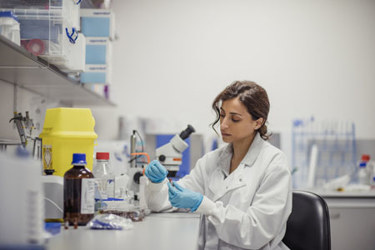Preformulation Of Excipients In Biologics Development
By Andrei Blasko, Clearview Pharma Solutions LLC

Biologics need to be manufactured, shipped, stored, and delivered to patients while minimizing their degradation. There are three common modes of denaturation and degradation: aggregation, oxidation, and deamidation. Depending on the complexity of the biomolecule, other types of degradation can take place: isomerization, fragmentation, disulfide scrambling, N- and O-glycosylation, clipping, and pyroglutamate formation. One of the most concerning degradation pathways is aggregation, which may trigger immunogenicity with the potential to cause adverse effects in patients.
To avoid potential degradation of drug product, the selection of the lead formulation is based on stability studies and other performance attributes. Most of the instability problems of a drug product (DP) come from excipients, in particular, from impurities in excipients. This is not surprising, considering that most ingredients in the drug product are excipients. Even a small percentage of reactive impurity in excipients, on a mol/mol basis, may cause undesired reactions and, thus, instability. This is more stringent for low-dose formulations, where the active pharmaceutical ingredient (API) is much lower than the formulation excipients.
To stabilize a drug product, you need to know not only the API but also its excipients. For biologics, I cannot emphasize enough the characterization and the choice of buffers for formulation.
Preformulation Expertise
Preformulation testing encompasses all studies on a new API to produce useful information for subsequent formulation of a stable and biopharmaceutically suitable dosage form.1 There is a scientific rivalry between the drug discovery and the drug development groups. Often, a novel molecule with remarkable cellular activity developed by the drug discovery group is stopped by the formulation group in taking it to a deliverable form. The preformulation group works with both ends to reduce the overall cost and the timeline of drug development. In some companies, the line between preformulation and formulation is a gray zone; those that keep the two groups separate achieve great rewards! However, in small pharma, there are fewer resources and the preformulation is done within the formulation group. In this case, you need to have the proper expertise in the group or consider hiring an expert.
Pharmaceutical Excipients Are Key To A Stable Drug Product
The drug discovery group already has preliminary data for the API, like its solubility in organic solvents, acidity constant (pKa), partition coefficient (logP/D), hygroscopicity, oxidation and light stability, and some solid-state properties (if the API is solid), etc. Some of the physicochemical properties need to be determined in a controlled manner (like pH – stability, or pH – rate profile) not only for regulatory submission but also as part of a more comprehensive experimental design that helps the formulation development (i.e., excipients selection).
Characterization of excipients in protein formulations (including buffers and sugars) is a must, and many physicochemical properties can be found in literature.2 Excipient compatibility is the second step and includes compatibility with the API (chemical/physical) and compatibility with the other excipients. Some are functional excipients like antioxidants, complexation agents, and surfactants, and their purity is also important (always ask the vendors for custom specifications, like peroxide content in ppm).
The performance of the final dosage form or its manufacturability depends on the excipients, their concentration, and their interaction with the API and with each other. No longer can excipients be regarded simply as inert or inactive ingredients, as described in ICH Q8(R2) Pharmaceutical Development. You need to address their physical and chemical properties, their safety, handling, and regulatory status. This is a must for novel excipients that need to be treated as API for characterization purposes. For approved excipients, I suggest starting with the Handbook of Pharmaceutical Excipients, where excipients are listed by functional category and in alphabetical order. For inhalation routes of administration, the list is much shorter; there are excipients for nebulizers, MDI, and DPI.3
Solubilization And Desolubilization By Excipients
One of the most powerful means of solubilizing nonpolar solutes in aqueous media is by using cosolvents. They are organic compounds that are miscible with water. Most are liquids but can include solids that are highly soluble in water (sugars, PEG, PVP). They have H-bond donors/acceptors that reduce H-bonding in H2O and have small hydrocarbon regions (<3) for each H-bond donor or acceptor that reduce the ability of water to “squeeze out” nonpolar solutes, therefore increasing solubility.4 In some instances, they are used for desolubilization if the solute is more polar than water (e.g., phenylalanine is desolubilized by ethanol). This is also important for processability in unit operations.
Cosolvents increase the API solubility (S), but strong electrolytes (salts) reduce the solubility of nonpolar solutes. Nonpolar solutes are solubilized more efficiently than polar solutes by nonpolar cosolvents; they reduce solvent-solvent (H2O) interactions. Generally, there is a linear relationship between the log S (nonpolar) in a mixed solvent and percent of volume of cosolvent. However, in some cases there is a nonlinear dependence with minima and maxima; therefore, it is important to determine the whole profile. For less nonpolar solutes there is a downward concavity of the curve at high cosolvent composition. The effect of multiple cosolvents on solubility is additive and the undesirable effects (toxicity, viscosity) are not.
Do not forget that organic solvents affect the ionization constant of your API.
Buffers Are Stabilizers
Buffers are defined as systems (particularly an aqueous solution) to resist a change of pH on adding acid or alkali, or on dilution with a solvent. For example, water has no ability to resist a change of pH, and CO2 from air equilibrated with water changes the pH from 7 to 5.7. Proteins are more stable at their isoelectric point (pI) value, but the pKa (and therefore, pI) shifts with ionic strength (µ) (acids shift down and bases up). For H2PO4-/HPO42- at µ=0.1, the pKa is decreased by 0.33.
Unbuffered solutions of neutral salts lack the ability to resist change of pH. On the other hand, weak acids and bases resist pH changes. It is important to know the buffering capacity (the amount of strong base needed to produce a change of pH of a fixed amount) as well as the Henderson-Hasselbalch equation behind it. A perturbation of 10% acid or base (e.g., mol. fraction 0.5 to 0.6) at pH = pKa has less effect on pH than at pH = pKa ± 1. For polyprotic buffers, if the pKa values are sufficiently far apart, treat them as monoprotic (e.g., phosphoric acid). Do not forget the temperature and ionic strength dependence on pKa. Biologics are sensitive to ionic strength and form aggregates. It is important to use the minimum buffer concentration in formulation that gives your API stability.
Common error alert: Never use a buffer outside its buffering capacity. Always adjust the pH of the stock so it is correct when diluted. A pH display reading of three decimal places gives a completely unjustified and false sense of confidence. When making buffers by the titration method, always start with the buffer species that has the lowest charge due to the ionic strength effect on pKa. For a robust manufacturing process, consider using premeasured buffer components.
Excipient-Drug Compatibility
By now, you are aware that most of the DP stability surprises are due to excipients. One needs to know the chemical reactivity of function groups in conjunction with drug–excipient, excipient–excipient, and impurities in both the drug and excipient (e.g., peroxides in PEG and its derivatives). The molecular mobility within the solid matrix, crystal defects, localized disordered regions, and amorphous content are sources of instability. The adsorbed water affects the mobility and the glass transition temperature (Tg).
The old approach for excipient compatibility was a binary mixture of the drug with the excipient in the ratio of 1:1, stressing the combination, followed by API analysis. However, common practice is to use a low API/excipient ratio and match as much as you can of the prospective formulation. Allow more physical interactions in the solid-state mixture (amorphous) and understand the reaction mechanisms. Physical interactions also affect physical stability.
Excipients Could Be Reactants
It is important to know your system and avoid reactive excipients. Some approved excipients are not reactive in the system they were approved for; however, they may be reactive in your formulation.
For example, when glucose (reducing sugar: can form an open chain, become aldehyde that can be oxidized; the other compound is reduced) is added to lyophilized relaxin, the amino groups in proteins react to form glucosamine (Maillard reaction). Lyophilized insulin with trehalose gives deamidation and dimerization via cyclic anhydride intermediate.5
Also, avoid deliquescent excipients; they will increase degradation. Do not forget the ink and coatings; TiO2 is a light blocker but also a photocatalyst.
Functional, Co-processed, And Novel Excipients
Functional excipients include antioxidants (vitamin E, BHT, ascorbic acid), complexation agents (cyclodextrins, EDTA), surfactants (SLS), and UV-light absorbers (phenyl salicylate, 2,4-dihydroxybenzophenone). For antioxidants, there are water-soluble and oil-soluble antioxidants (for emulsion formulations, both need to be added). Using more than one antioxidant is often effective. However, you should know their mechanism of action.
In co-processed excipients (combination of existing pharmacopeial excipients), at least one non-performance-related property must be different, produced by high-shear dispersion, granulation, spray drying (e.g., fumed silica with microcrystalline cellulose), or melt extrusion.
A novel excipient is an excipient never used in a marketed product or is used at a level higher than in a marketed product or in a different route of administration. Novel excipients are treated as API for tox, impurity profiling (including analytical methods), and physicochemical characterization. The definition of novel excipients differs between the U.S./EU and Japan. One should not neglect the new regulatory guidance on genotoxic (ICH M7) and elemental impurities (ICH Q3D), as well as on excipient performance (USP<1059>). The Brazilian ANVISA’s resolution RDC 53/2015 (articles 4, 5, and 6) is expanded beyond the ICH guidelines and includes requirements on specific forced degradation experimental conditions (including excipients) and the extent of degradation to which the pharmaceutical companies must comply for registration filing.
References:
- Akers, M. J. Can. J. Pharm. Sci. 1976, 11, 1-10
- Capelle, M. A. H. et all. Eur. J. Parm. Biopharm. 2007, 65, 131
- Pilcer, G.; Amighi, K. Int. J. Pharm. 2010, 392,1–19
- Samuel H. Yalkowsky, Solubility and Solubilization in Aqueous Media, Oxford Univ. Press, New York, NY, 1999
- Yoshioka, S. et al, Pharm. Res. 2006, 23, 961-966
About the Author
 Andrei Blasko is president and chief executive officer of Clearview Pharma Solutions, LLC, a consulting company for drug development. He spent more than 20 years in the pharmaceutical industry discovering and developing new drugs including small molecules and biologics. After completing two postdoctoral positions at the University of California Santa Barbara, he worked at Roche, Sugen/Pharmacia/Pfizer, Celera, Pain Therapeutics, now Cassava Sciences Inc., and Novartis. Reach him at andrei@clearviewpharmallc.com.
Andrei Blasko is president and chief executive officer of Clearview Pharma Solutions, LLC, a consulting company for drug development. He spent more than 20 years in the pharmaceutical industry discovering and developing new drugs including small molecules and biologics. After completing two postdoctoral positions at the University of California Santa Barbara, he worked at Roche, Sugen/Pharmacia/Pfizer, Celera, Pain Therapeutics, now Cassava Sciences Inc., and Novartis. Reach him at andrei@clearviewpharmallc.com.
